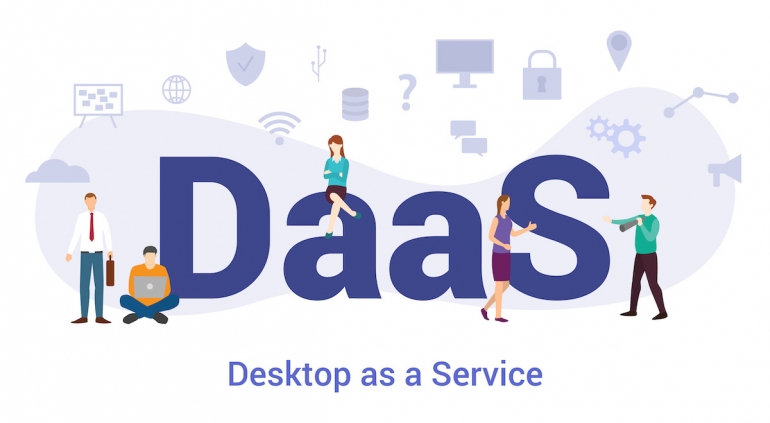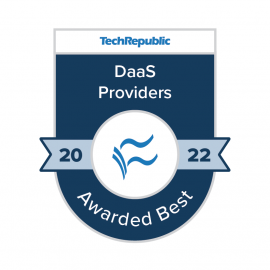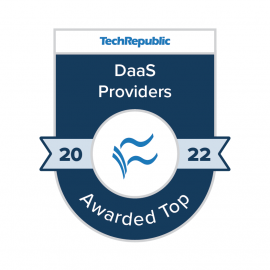
Desktop as a service is a virtual desktop infrastructure hosted in the cloud and paid for as a subscription service, usually charged for by the seat. DaaS solutions use a multi-tenancy architecture where a single application instance is delivered to multiple users, also called tenants. The third-party service provider assumes the responsibility for managing the desktop infrastructure.
Jump to:
Top DaaS providers
Here’s a look at many of the major players in the desktop as a service market and the services they offer. The service providers are listed in alphabetical order by company name.
Amazon WorkSpaces


Public cloud compatibility: Amazon Web Services
Minimum term: <1 month
Minimum seats: One
Pricing: Monthly or hourly; dependent on geographic region
Amazon launched WorkSpaces, its proprietary cloud desktop service, in 2013. Customers are charged for only the WorkSpaces they use and can pay either monthly or hourly.
Companies can provision either Linux or Windows desktops on a wide variety of virtual hardware and storage configurations. If deploying Windows desktops, companies can use their own Windows 10 Enterprise licenses (if they meet Microsoft’s licensing requirements) or pay for them as part of the WorkSpaces subscription.
Amazon offers a default set of applications with each WorkSpace depending on the operating system. Linux desktops include applications such as LibreOffice, Firefox and Evolution mail. Customers can add additional software from the Amazon Linux repositories with yum. Windows 10 desktops include applications such as Internet Explorer 11 and Firefox. Customers can also add various versions of Microsoft Office Professional 2016 for an additional cost or build their own custom images.
When it comes to end-user credentialing and management Amazon WorkSpaces supports “Simple AD, AD Connector or AWS Directory Service for Microsoft Active Directory, also known as AWS Managed Microsoft AD.” Customers can also establish a trust relationship between their AWS Managed Microsoft AD directory and their on-premises domain.
Applications can be deployed to the virtual desktops via existing tools, and WorkSpaces allows customers to use their existing RADIUS server for multi-factor authentication (MFA). Users can access their WorkSpaces via a client application on a Windows or Mac computer, Google Chromebook, Apple iPad, Amazon Fire tablet and Android tablet, or through either the Chrome or Firefox browsers. WorkSpaces supports encryption root volume and user volume encryption and does not store user data on the local device. Amazon WorkSpaces also provides multiple compliance options including, but not limited to HIPAA, PCI DSS and GDPR.
If we had to choose our favorite DaaS option, that award would go to Amazon WorkSpaces. The Amazon WorkSpaces service not only offers the ability to run both Linux and Windows desktops, but you are also only charged for the workspaces you use, and it’s on one of the strongest backbones on the planet: AWS. The single-seat minimum makes for a compelling reason to choose as well.
Given that the pricing is monthly or hourly depending on your geographical region, you’re not looking at outrageous costs for using the service either. Because Amazon WorkSpaces can be HIPAA, PCI DSS and GDPR, these virtual desktops can be used when sensitive data is required. Most importantly, Amazon WorkSpaces can deploy either Linux or Windows on several different virtual hardware configurations, and with Amazon’s incredible storage facilities, you can trust those environments will remain both safe and reliable.
Citrix Managed Desktops


Public cloud compatibility: Azure
Minimum term: 1 month
Minimum seats: 25
Pricing: Monthly or Term (1 to 5 years)
Longtime remote desktop, thin-client and virtualization provider Citrix released its desktop as a service solution, Citrix Managed Desktops, to general availability in August 2019. The company already offered a from of DaaS through Citrix Virtual Apps and Desktops, but this solution required companies to deal with multiple vendors. Citrix Managed Desktops is designed to be a simplified version of CVAD and a “turnkey service” where all costs are billed directly to Citrix.
CMD uses Microsoft Windows Virtual Desktop to deliver virtual desktops hosted on Microsoft Azure IaaS (compute, storage and networking) and managed by Citrix. Customers can provision a variety of Windows machines, including: Windows 10 Enterprise, Windows 10 EVD (Enterprise Virtual Desktops) Multi-Session and Windows Server 2016 with RDSH. The operating system and application licenses can be paid for through the Citrix subscription or customers can use their existing licenses through a Bring Your Own License program. CMD will offer a variety of AD authentication options and support domain-joined and non-domain-joined desktops.
Citrix Managed Desktop pricing varies significantly based on the type of service customers choose and the length of service contract When Citrix introduced CMD in May 2019, they said customers would expect to pay about $30 per user per month for CMD for a minimum of 25 users and at their Synergy event in May 2019, Citrix broke down that ~$30 monthly price for Managed Desktops even further.
However, as of August 2020, CMD pricing on Citrix’s website, breaks down as follows:
- $8/month U.S Term commitment (per user; assumes 500 users and a 3-year contract)
- $15/month (US) Workspace Standard with Citrix Managed Desktop (per user; assumes 500 users and a 3-year contract)
- $16/month (US) Pay-as-you go monthly subscription (per user)
Looking to level up your knowledge on Citrix Managed Desktops? Check out this course!
Cloudalize Desktop-as-a-Service


Public cloud compatibility: N/A
Minimum term: 1 month
Minimum seats: One
Pricing: Hourly or monthly
Belgium-based Cloudalize provides a DaaS solution optimized for power users in Europe and North America. Subscriptions include the cost of operating system licenses, but customers will need their own application licenses. According to a 2018 Gartner report, the company “hosts its own data centers using both Citrix and proprietary infrastructures” and “all workspaces must run a Windows 10 experience on a Windows 2016 Server.” As of August 2020, prices for Cloudalize DaaS start at $0.89/hour (US) plus a standard monthly recurring charge of $19.99 (US).
dinCloud dinWorkspace


Public cloud compatibility: N/A
Minimum term: 1 month
Minimum seats: Five
Pricing: Monthly
dinCloud’s dinWorkspace DaaS solution allows customers to provision virtual desktops that are hosted on hardware in dinCloud’s US-based data centers. According to dinCloud, it’s data centers “maintain SOC 1 Type II and SOC 2 Type II compliance, ISO 27001, NIST 800-53/FISMA and PCI Compliance.” Customers can provision a variety of Windows and/or Linux desktops managed through Citrix-based, Microsoft-based or proprietary tools.
Evolve IP


Public cloud compatibility: N/A
Minimum term: 12 months
Minimum seats: 25
Pricing: Monthly
Cloud services company Evolve IP delivers its DaaS solution using VMware View and PC-over-IP. Evolve IP’s virtual Windows desktops can be accessed from a variety of end points, including Windows and Mac computers, thin clients, IOS, Android, ChromeOS devices or web browsers that support HTML5. Evolve IP supports both VMware and Citrix stacks and virtual machines are hosted in the company’s US-based data centers.
Customers that have a Microsoft Open/Volume license for Windows can use Windows VDA with Evolve IP’s DaaS solution. As an Authorized Qualified Multitenant Hosting Partner with Microsoft, Evolve IP can support full versions of Office 365 and Exchange access. They also support bring-your-own-licensing and open-source licensing. Evolve IP offers a range of compliance and security certifications, including SOC2, HIPAA, HITRUST CSF and PCI DSS.
itopia Cloud Automation Stack (CAS)


Public cloud compatibility: Google Cloud
Minimum term: 12 months (1 to 3 year negotiated contract)
Minimum seats: 5-10 VMs
Pricing: Billed hourly on a month-to-month basis
Founded in 2013, itopia offers a software as a service (SaaS) solution called Cloud Automation Stack. The company’s proprietary automation and orchestration tool works exclusively with Google Cloud Platform. Using CAS, customers can deploy and manage workloads, virtual desktops, virtual servers and virtual apps in a GCP environment. Through the CAS web interface, IT administrators “can manage all aspects of DaaS across both the Microsoft Windows server infrastructure as well as those of Google Cloud Compute Engine.”
CAS virtual desktops can support either Windows 8.1 or Windows 10. itopia can also provision Windows Server images available in Google Cloud, including Windows Server 2012 R2, 2016 and 2019. End users can access their virtual desktops from devices that support RDP, RemoteFX, RemoteApp feeds or an HTML5 browser, such a Windows and macOS laptops/desktops, iOS and Android devices, Chromebooks and Chromeboxes and thin-clients.
There is no minimum number of end-user seats, but deployments automated through CAS require a minimum of five to 10 virtual machines. If a customer doesn’t provision a specific number of user seats, they are billed for the VMs as if they were seats. Basically, customers are billed for the number of servers or seats, whichever is greater. Customers that sign up through the GCP Marketplace and billed hourly on a month-to-month basis for their units (seats or servers). When it comes to operating system and application licenses, all third-party licenses must be provided by the customer, since the VMs are running on the customer’s own Google Cloud account.
What is desktop as a service?
As with other cloud services, DaaS is an attractive solution for companies moving away from managing their own hardware either in an on-premise data center or co-location. DaaS benefits can include easier patch management and software updates, faster migrations, quicker new user provisioning, better disaster planning and recovery, and improved application and data security.
The costs of deploying and maintaining the hardware required to run each virtual desktop shifts from a capital expense to operational expense. Users can also benefit from DaaS by being able to access corporate data and applications through a desktop experience on a wide range of either company-provided or BYOD devices using a network or internet connection.
DaaS market trends and adoption rates
In 2019, DaaS vendors made several major moves. Microsoft made their DaaS solution, Windows Virtual Desktop, generally available September. Citrix Managed Desktops moved to general availability in August and Dell and Microsoft announced cloud and virtualization partnerships focused around VMware. Yet despite the benefits of DaaS and these market shifts, adoption remains lower than some expected.
In Gartner’s 2016 DaaS report, analysts predicted that “by 2019, 50% of new VDI users will be deployed on DaaS platforms” as the deployment of DaaS solutions “cannibalize on-premises VDI at refresh.” But in a 2018 survey, Gartner found that DaaS adoption was still significantly lower than VDI adoption, especially among large enterprises.
In its 2019 Market Guide for Desktop as a Service report, Gartner noted that by 2023 they expect that “price reductions and product maturity will lead organizations to move 20% of VDI users into DaaS offerings in the cloud,” significantly less than their earlier predictions. Furthermore, Gartner noted that DaaS “progress has been stymied somewhat by the fresh injection of hype from Microsoft’s entry into the DaaS market.”
Despite the limited adoption of DaaS, Gartner did point to growth in the market.
“Microsoft’s entry into the desktop as a service (DaaS) market has dominated Gartner inquiries since September 2018 and rejuvenated interest in DaaS maturity and business value,” the research company noted. “[DaaS is] now being adopted by midsize and large enterprise organizations, primarily for disaster recovery, and elastic and temporary use cases.”
Given the increase in remote work as a result of the COVID-19 pandemic, it wouldn’t be unrealistic to see an uptick in interest around technologies that provide secure remote workspaces like VDI and DaaS.
Note: This article was written by Bill Detwiler and updated by Jack Wallen.
